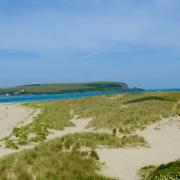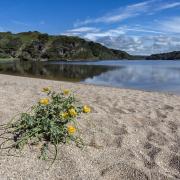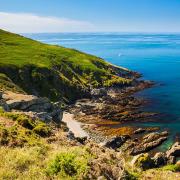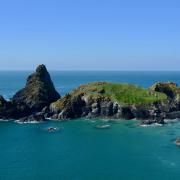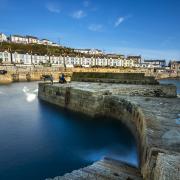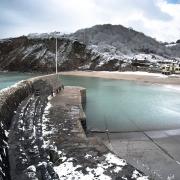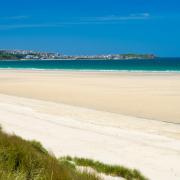In this October issue we unearth a geological mystery at Porthleven called Giant's Rock
Something very odd has been going on at Porthleven. A little way along the rocky foreshore, beyond the north-western side of the harbour entrance, an alien object has come to rest. In the past, this must have provoked equal amounts of wonder and bafflement amongst the local community. Our forebears were, however, closer to the land than most of us are nowadays.
They had the time to be keen observers of their surroundings, and would have realised that this object was unlike anything within their compass of knowledge. They sensed that it must have arrived mysteriously from some far distant place, and that superhuman forces would have been needed to transport it. It is so heavy that even during the memorable storm of December 1989, when Porthleven became famous for its astonishing images of the destructive power of the sea, it did not budge. At some distant and undocumented time our ancestors, with good reason, called it the Giant's Rock.
Giants are common currency in Cornwall. There are numerous myths and legends of giants, usually associated with high rocky places or hill forts, and with an underlying theme of violence. I suspect that these myths, originally documented by Victorian collectors of folk tales who were anxious to preserve what had been simply oral traditions, have been embellished by the early promoters of tourism. Nonetheless, legends of giants are doubtless of very ancient date, and can probably be traced back at least to skirmishes with Viking or Danish raiders, whose superior height would have made a deep impression on our stocky Celtic ancestors. Rather in the manner of fishermen's tales, or stories I have heard from tourists of encounters with adders along the coast path - serpents of a size that would not be out of place in an African rainforest - the ones that got away grow larger with the retelling. Giants would have been in the folk memory for more than a thousand years, convenient symbols to which inexplicable natural features could be attached.
Today we have, partly, a scientific explanation. The Giant's Rock is a fine example of what geologists call an 'erratic', a great rock plucked from its original source and transported by glacial action to its present site. The movement of ice is one of nature's most inexorable forces. During the Ice Ages, most of Britain was smothered under a massive ice sheet that advanced from the Arctic. The sheer weight of ice, grinding ponderously over the bare surface of the land - for all vegetation would have vanished as the cold intensified - ripped whole mountainsides apart, gouging new valleys, pushing the shattered debris forward and remoulding the landscape. Much of modern Britain is strewn with these glacial remains, which range from great blocks of erratics, transported sometimes hundreds of miles from their points of origin, to fine silts where glaciers literally ground the bedrock to flour, the whole being abandoned as the ice finally melted and retreated northwards.
A problem with the Giant's Rock is that the ice sheets never reached Cornwall, where the land remained exposed, albeit in a frigid state, even during the periods of most intense cold. The Giant's Rock is technically termed gneiss, a rock that has been metamorphosed by earth-moving forces to grow new minerals, including small garnets - semi-precious stones. No source area for this garnet-gneiss has been identified with any confidence. It could have come from Scotland, Scandinavia, or even as far afield as Greenland.
The coastal location holds a partial clue. The Cornish seas during the Ice Age would have been full of icebergs that had calved from the main ice sheets, drifting with storms and carrying their ballast of trapped, frozen-in rock. The concept of transport by iceberg offers an elegant explanation as to how the Giant's Rock could have found its way beyond the ice sheet, but still a mystery remains. With so much water locked up in the ice sheets, sea levels were much lower than they are today. The coastline would have been substantially further offshore, with any rock-bearing icebergs drifting well out in Mount's Bay, unable to float the Giant's Rock to where it presently sits.
We are almost in the same quandary as our ancestors, who invoked the power of giants to bring the rock to Porthleven. Probably the best we can do today is to postulate the kind of catastrophic event so beloved of TV documentaries. Was there a gigantic collapse into the sea of a huge part of the ice sheet, or perhaps an earthquake-induced tsunami washed into the funnel shape of Mount's Bay, towering to monstrous heights and sweeping all before it? Did an iceberg, with its rocky cargo, finally become stranded amidst a welter of destruction as the waves receded, eventually to melt and release our Giant's Rock?
I can think of no other place in Cornwall which so readily illustrates the conundrum of the irresistible force and the immovable object. The Giant's Rock stands on its uneven platform, a sentinel beside a limpid rock pool, silently keeping its secrets. Perhaps it has survived the kind of geological upheavals which, if repeated, would dwarf the currently perceived threats to our environment.





